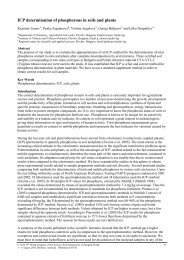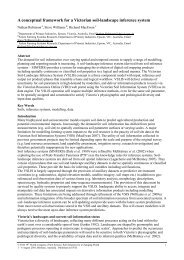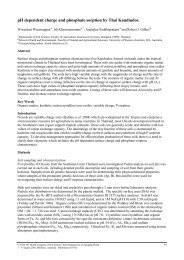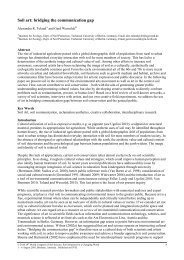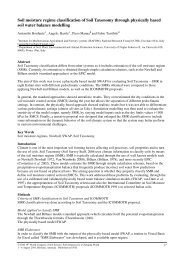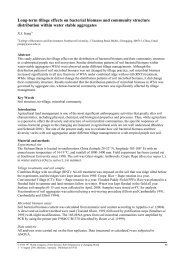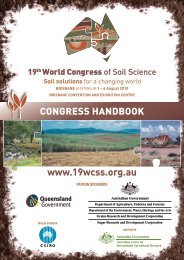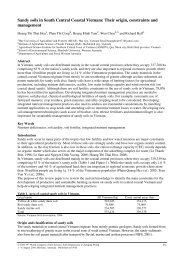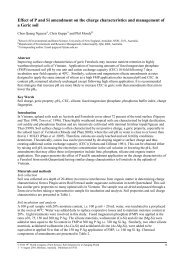Kaneko Shinji
Kaneko Shinji
Kaneko Shinji
Create successful ePaper yourself
Turn your PDF publications into a flip-book with our unique Google optimized e-Paper software.
A simple method for the determination of nitrate in potassium chloride extracts<br />
from forest soils<br />
<strong>Shinji</strong> <strong>Kaneko</strong> A , Masahiro Inagaki A and Tomoaki Morishita A<br />
A Department of Forest Site Environment, Forestry Forest Products Research Institute, 1 Matsunosato, Tsukuba, Ibaraki, Japan, Email<br />
kanekos@affrc.go.jp<br />
Abstract<br />
We developed a simple method to determine NO 3 - -N in KCl extracts from forest soils. The measurement<br />
principle of the method is based on the difference of the spectral adsorption properties between dissolved<br />
organic carbon (DOC) and nitrate. In this method, NO 3 - -N concentration was obtained by measuring the<br />
absorbance of KCl extracts at 220nm and 260nm wavelengths. We term this method as the UV method. We<br />
measured NO 3 - -N concentration of fifty six KCl extracts from six forest soils in central and western Japan by<br />
using the UV method. The results were highly correlated to those by the automated Cd reduction method. It<br />
suggests that the UV method is a reliable method to determine NO 3 - -N in KCl extracts. It is the most simple<br />
procedure to determine NO 3 - -N in KCl extracts from forest soils.<br />
Key Words<br />
Nitrate, rapid determination, forest soils, available nitrogen, nitrogen mineralization.<br />
Introduction<br />
Nitrogen is a most important nutrient for higher plants, so available nitrogen and nitrogen mineralization<br />
potential of soils are indicators for soil fertility. This nitrogen is evaluated by the amounts of NH 4 + -N and<br />
NO 3 - -N that are extracted with KCl solution from soils. For determining NO 3 - -N, expensive equipments or<br />
time consuming methods such as flow injection (automated Cd reduction methods) and Kjeldahl<br />
determination method are needed. So, several rapid methods have been devised for NO 3 - -N determination<br />
(Cataldo et al. 1975; Kanno et al.1968; Norman and Stucki 1981; Sakata 2000; Yang et al. 1998). Yang et<br />
al. (1998) developed a simple method by applying the salicylate method (Cataldo et al. 1975;Kanno et<br />
al.1968). This method is very simple but it needs some steps such as reagent adding and heating.<br />
The aim of this study was to develop more simple method for determining NO 3 - -N in KCl extracts. NO 3 - -N<br />
could be determined by a UV absorption method in solution where the dissolved organic carbon (DOC)<br />
concentration is low. The UV absorption method, however, cannot be applied for the determination of NO 3 - -<br />
N in KCl extracts from forest soils because these solutions usually contain considerable amount of DOC.<br />
DOC absorbs light at all wavelengths between 200 nm and 300nm. The absorbance of DOC gradually<br />
decreases from 200 nm to 300nm. On the other hand, NO 3 - -N also absorbs UV light at less than 250 nm<br />
wavelength. Based on the difference of UV absorption properties between DOC and NO 3 - - N, we developed a<br />
NO 3 - -N determination method.<br />
Methods<br />
Fourteen surface soil samples were collected from the forests in Mt. Tsukuba and Mt. Kaba, Ibaraki<br />
prefecture, Japan (Table 1). DOC was extracted from each soil by 100 ml of water added to 20g of Soil. NO 3<br />
-<br />
-N in the extracts was removed with ion exchange resins (the mixture of Amberlite IR120 and Amberlite<br />
IRA410). We measured absorption spectra of each extract within 200 nm to 300 nm by a spectrophotometer<br />
(Shimadzu UVmini-1240). We calculated the ratio of the absorbance at 220nm to that at 260nm in each<br />
extract and used the mean value of the ratio in the following nitrate estimations. NO 3 - -N was extracted with<br />
2M KCl solution from thirty-nine soil samples collected from a Japanese cedar forest and a Japanese cypress<br />
forest in Mt. Tsukuba. We measured the absorbance at 220nm and 260nm in each 2M KCl extracts. We also<br />
measured the absorbance at 220nm and 260nm of 2M KCl extracts from seventeen soil samples that were<br />
collected in forests in Kobe, Ehime and Kagoshima in western Japan. Then, the 220nm absorbance<br />
originated from NO 3 - -N ([UV220] NO3 ) was estimated by the following formula.<br />
[UV220] NO3 = [UV220] - [UV260]* K 220/260 (1)<br />
Here, [UV220] is an absorbance value at 220nm in the extracts. [UV260] is an absorbance value at 260nm in<br />
the extracts. K 220/260 is the ratio of the absorbance at 220nm to that at 260nm originated from DOC.<br />
© 2010 19 th World Congress of Soil Science, Soil Solutions for a Changing World<br />
1 – 6 August 2010, Brisbane, Australia. Published on DVD.<br />
4
Table 1. General information of soil samples and number of samples for water and KCl extraction.<br />
Location Latitude Longitude Vegetation A Soil Type B Parent Materials Water extract<br />
Number<br />
KCl extract<br />
Number<br />
Tsukuba 36°10′N 140°10′E Japanese cypress BD Volcanic Ash, Gneiss 2 20<br />
Tsukuba 36°10′N 140°10′E Japanese cedar BD Volcanic Ash, Gneiss 4 19<br />
Kaba 36°18′N 140° 9′E Deciduous Forests BD(d) Volcanic Ash, Granite 8 --<br />
Kochi 33°28′N 133°00′E Japanese cypress BlD Volcanic Ash -- 7<br />
Kobe 34°43′N 135°10′E Japanese cedar BD Tertiary sediment -- 6<br />
Ehime 33°53′N 132°52′E Mousoutiku BD(d) Hornfels -- 4<br />
Bamboo forests<br />
A Japanese cypress: Chamaecyparis obtusa, Japanese cedar: Cryptomeria Japonica, Mousoutiku: Phyllostachys<br />
pubescens. B According to classification of forest soils in Japan (1975), BD: Moderately moist brown forest soils, BD(d)<br />
Moderately moist brown forest soils (drier subtype), BlD: Moderately moist black soils<br />
NO 3 - -N concentration at the KCl extracts was determined by comparing [UV220] NO3 with the absorbancy of<br />
NO 3 - -N standard solution. NO 3 - -N concentration of each extract was also measured by the automated Cd<br />
reduction methods (Dia Instrument FI-N50). We call the former the UV method and the latter the automated<br />
Cd reduction method.<br />
Results<br />
The absorption spectra of DOC and NO 3 - -N<br />
Each water extract after deionization showed UV absorption, and its optical density was least at 300nm and<br />
gradually increased toward shorter wavelength (Figure 1). These extracts did not contain NO 3 - -N, so the<br />
absorption curve observed was considered to be derived from DOC. On the contrary, the adsorption curve of<br />
NO 3 - -N has no absorption in the range from 250nm to 300nm and abruptly increased at 240nm. The mean<br />
value of the ratio of absorbancy at 220nm to at 260nm was 1.543 in water extracts after deionization for<br />
fourteen soil/water extracts (Table 2), so we adopted 1.543 as the value of K 220/260 in the equation (1).<br />
ABS<br />
3<br />
2<br />
NO3<br />
Soil 1<br />
Soil 2<br />
Soil 3<br />
1<br />
0<br />
200 210 220 230 240 250 260 270 280 290 300<br />
Wave len gth<br />
Figure 1. The absorption curves of three soil/water extracts after deionization and that of NO 3 - -N solution.<br />
The comparison of the UV method with the automated Cd reduction method<br />
We compared the data by the UV method with those determined by the automated Cd reduction method for<br />
2M KCl extracts from Mt. Tsukuba soils (Figure 2, left). There was a good relationship between the UV<br />
method and the automated Cd reduction method (Y=1.040X-0.124, R 2 =0.993). If the absorbancy at 220nm of<br />
DOC was assumed to be 0, the slope of the regression line was 0.753. This indicated that NO 3 - -N<br />
concentration by the UV method was overestimated compared with the automated Cd reduction method<br />
(Figure 2, right). We also compared both methods for NO 3 - -N determination in KCl extracts from Kobe,<br />
Ehime and Kochi soils (Figure 3, left). The data for the UV method also were highly correlated with those by<br />
the automated Cd reduction method (Y=1.099X-0.421, R 2 =0.989). On the other hand, in case no<br />
compensation was carried out for the absorbancy at 220nm, NO 3 - -N concentration by the UV method was<br />
overestimated (Figure 3, right).<br />
Discussion<br />
Several simple methods have been proposed for the NO 3 - -N determination (Cataldo et al. 1975; Kanno et<br />
al.1968; Norman and Stucki 1981; Sakata 2000; Yang et al. 1998). These methods are simple but they need<br />
some steps such as reagent adding and heating. The UV method, we developed, is more simple. It only needs<br />
only a spectrophotometer and the measurement of absorbancy at 220nm and 260nm. It is the most simple<br />
procedure to determine NO 3 - -N in KCl extracts from soils.<br />
© 2010 19 th World Congress of Soil Science, Soil Solutions for a Changing World<br />
1 – 6 August 2010, Brisbane, Australia. Published on DVD.<br />
5
Table 2. The ratio of absorbance at 220nm to at 260nm in soil/water extracts after deionization.<br />
Location Vegetation Soil depth UV220 UV260 K220/260<br />
(cm)<br />
Tsukuba Japanese Cypress 0-5 1.054 0.637 1.655<br />
Tsukuba Japanese Cypress 0-5 0.526 0.33 1.594<br />
Tsukuba Japanese Cedar 0-5 0.681 0.446 1.527<br />
Tsukuba Japanese Cedar 0-5 0.645 0.443 1.456<br />
Tsukuba Japanese Cedar 0-5 0.569 0.375 1.517<br />
Tsukuba Japanese Cedar 20-25 0.309 0.179 1.726<br />
Tsukuba deciduous Forests 0-5 2.382 1.551 1.536<br />
Kaba deciduous Forests 5-15 2.901 1.953 1.485<br />
Kaba deciduous Forests 15-30 0.457 0.287 1.592<br />
Kaba deciduous Forests 0-5 2.868 1.938 1.48<br />
Kaba deciduous Forests 5-15 0.31 0.204 1.52<br />
Kaba deciduous Forests 15-30 0.409 0.261 1.567<br />
Kaba deciduous Forests 0-10 1.059 0.717 1.477<br />
Kaba deciduous Forests 20-30 0.912 0.62 1.471<br />
mean 1.543<br />
Max. 1.726<br />
Min. 1.456<br />
S.D. 0.077<br />
8<br />
8<br />
Th e common meth od<br />
6<br />
4<br />
2<br />
y = 1.040 x - 0.124<br />
R 2 = 0.993<br />
The common meth od<br />
6<br />
4<br />
2<br />
y = 0.753 x + 0.033<br />
R 2 = 0.859<br />
0<br />
0 2 4 6 8<br />
Th is method<br />
0<br />
0 2 4 6 8<br />
Th is meth od (no compen sation )<br />
Figure 2. Comparison of NO 3 - -N concentrations by the UV method (this method) with those by the automated<br />
Cd reduction method (the common method) for KCl extracts from Tsukuba soils (Unit is mg N/L). K 220/260 =<br />
1.543 in the left figure. K 220/260 =0 in the right figure.<br />
15<br />
15<br />
The common meth od<br />
10<br />
5<br />
0<br />
y = 1.099 x - 0.421<br />
R 2 = 0.996<br />
0 5 10 15<br />
Th is method<br />
Th e common meth od<br />
10<br />
5<br />
0<br />
y = 1.044 x - 1.593<br />
R 2 = 0.950<br />
0 5 10 15<br />
This method (no compen sation )<br />
Figure 3. Comparison of NO 3 - -N concentrations by the UV method (this method) with those by the automated<br />
Cd reduction method (the common method) for KCl extracts from Kobe, Ehime and Kagoshima soils (Unit is mg<br />
N/L). K 220/260 = 1.543 in the left figure. K 220/260 =0 in the right figure.<br />
© 2010 19 th World Congress of Soil Science, Soil Solutions for a Changing World<br />
1 – 6 August 2010, Brisbane, Australia. Published on DVD.<br />
6
The accuracy of the UV method depends on the value of K 220/260 in the equation(1). K 220/260 varied from<br />
1.456 to 1.726 in the fourteen soil/water extracts. In the case of K 220/260 =1.456, the slope, the y-intercept<br />
and the R 2 of the regression line, are calculated to be as 1.064, 0.106 and 0.996 for the KCl extracts from<br />
Tsukuba soils, respectively. In the case of K 220/260 =1.726, the slope, the y-intercept and the R 2 are 1.027,<br />
0.128 and 0.991, respectively. Each parameter is almost same in the case of K 220/260 =1.543 (Figure 2, left).<br />
This result suggests that the value of NO 3 - -N estimation would be almost constant even if the value of K 220/260<br />
varied to some extent. The NO 3 - -N estimated by the UV method is highly correlated with values for the<br />
automated Cd reduction method for KCl extracts from forest soils in western Japan (Figure 3, left). However,<br />
as for the slope and the y-intercept of the regression line, the correspondence of two methods is somewhat<br />
low compared with the case of Tsukuba soils. The soil type of the Kochi soils is different from that of<br />
Tsukuba soils and vegetation for Ehime soils is different from that of Tsukuba soils (Table 1). We assumed<br />
that the K 220/260 of DOC is constant in KCl extracts from soils but the low correspondence suggests that the<br />
K 220/260 of DOC may vary with soil type and vegetation type. We need more information about K 220/260 of<br />
DOC extracted from soils under different environments.<br />
Conclusion<br />
The method that we developed to determine NO 3 - -N in KCl extracts, only needs a spectrophotometer and the<br />
measurement of absorbance at 220nm and 260nm. We conclude that it is the simplest procedure to determine<br />
NO 3 - -N in KCl extracts from forest soils.<br />
References<br />
Cataldo DA, Haroon LE, Schrader LE, Youngs VL (1975) Rapid colorimetric determination of nitrate in<br />
plant tissue by nitration of salicylic acid. Communications in Soil Science and Plant Analysis 6, 71–80.<br />
Kanno S, Fukui S, <strong>Kaneko</strong> M (1968) Hygienic chemical studies on public water. VI. Determination of nitrate<br />
nitrogen in water sodium salicylic acid method. Eisei Kagaku 14, 14-29 (In Japanese).<br />
Norman RJ, Stucki JW(1981) The determination of nitrate and nitrite in soil extracts by ultraviolet<br />
spectrophotometry. Soil Sci. Soc. Am. J. 45, 347-353.<br />
Yang JE, Skogley EO, Schaff BE, Kim JJ (1998) A simple spectrophotometric determination of nitrate in<br />
water. Soil Science Society of American Journal 62, 1108-1115.<br />
© 2010 19 th World Congress of Soil Science, Soil Solutions for a Changing World<br />
1 – 6 August 2010, Brisbane, Australia. Published on DVD.<br />
7



